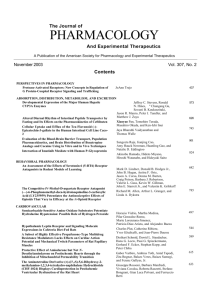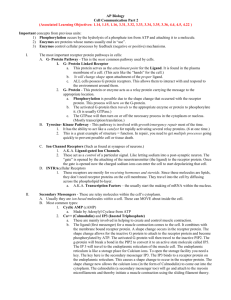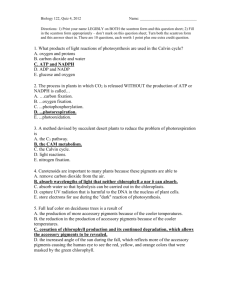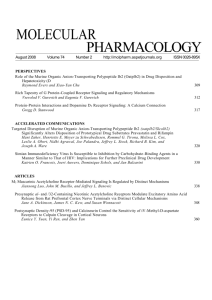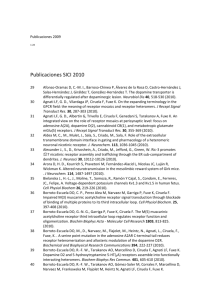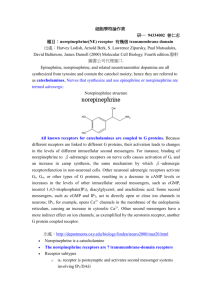catalytic receptors
advertisement
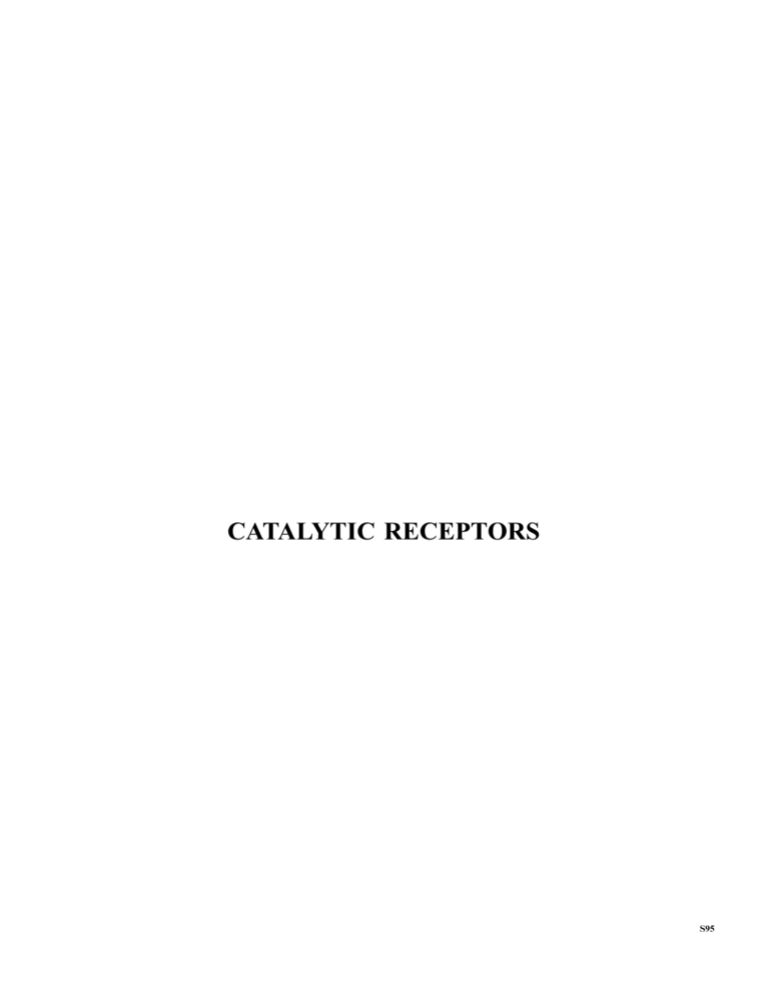
CATALYTIC RECEPTORS S95 S96 GDNF family Alexander et al GDNF family Overview: GDNF family receptors (GFR, provisional nomenclature) are glycosylphosphatidylinositol-linked cell-surface receptors, which, when activated by members of the glial cell-derived neurotrophic factor (GDNF) family, activate a transmembrane tyrosine kinase enzyme, Ret (ENSG00000165731). The endogenous ligands are typically dimeric, linked through disulphide bridges: GDNF; (211 aa, ENSG00000168261); neurturin (197 aa, ENSG00000171119); artemin (237 aa, ENSG00000117407) and persephin (156 aa, ENSG00000125650). Nomenclature GFRa1 GFRa2 GFRa3 GFRa4 Other names GDNF, GNDF family receptor a1 ENSG00000151892 GDNF4neurturin4artemin Neurturin, GNDF family receptor a2 ENSG00000168546 Neurturin4GDNF Artemin, GNDF family receptor a3 ENSG00000146013 Artemin Persephin, GNDF family receptor a4 ENSG00000125861 Persephin Ensembl ID Potency Order Mutations of Ret and GDNF genes may be involved in Hirschsprung’s disease, which is characterized by the absence of intramural ganglion cells in the hindgut, often resulting in intestinal obstruction. Further reading: AIRAKSINEN, M.S. & SAARMA, M. (2002). The GDNF family: signalling, biological functions and therapeutic value. Nat. Rev. Neurosci., 3, 383 – 394. BALOH, R.H., ENOMOTO, H., JOHNSON, E.M. & MILBRANDT, J. (2000). The GDNF family ligands and receptors – implications for neural development. Curr. Opin. Neurobiol., 10, 103 – 110. SAARMA, M. (2000). GDNF – a stranger in the TGF-b superfamily? Eur. J. Biochem., 267, 6968 – 6971. Natriuretic peptide Alexander et al S97 Natriuretic peptide Overview: Natriuretic peptide receptors (NPR, provisional nomenclature) are homodimeric, catalytic receptors with a single TM domain and guanylyl cyclase (EC 4.6.1.2) activity on the intracellular domain of the protein sequence. Isoforms are activated by the peptide hormones a-atrial natriuretic peptide (ANP, ENSG00000175206), brain natriuretic peptide (BNP, ENSG00000120937) and type C-natriuretic peptide (CNP, ENSG00000163273). Another family member is the receptor for guanylin (ENSG00000113389) and uroguanylin (ENSG00000044012). Family members have conserved catalytic and regulatory domains, but divergent ligand-binding domains. The NPR3 receptor has an extracellular binding domain homologous to that of the NPR1 and 2 receptors, but with a truncated intracellular domain which appears to couple to inhibition of adenylyl cyclase activity (Murthy & Makhlouf, 1999). Nomenclature NPR1 NPR2 NPR3 STaR Other names GC-A, ANPA receptor, NPR-A ENSG00000169418 ANPXBNPbCNP ANP, sANP (Olson et al., 1996) [Asu7,230 ]-b-ANP-(7 – 28) (7.5, Kambayashi et al., 1989) [125I]-ANP GC-B, ANPB receptor, NPR-B ENSG00000159899 CNPbANPXBNP CNP ANPC receptor, NPR-C, clearance receptor ENSG00000113389 ANP4CNP4BNP C-ANP-4 – 23 (Maack et al., 1987) F GC-C, guanylin receptor [125I]-ANP F Ensembl ID Potency order Selective agonists Selective antagonists Radioligands Monoclonal antibody 3G12 (Drewett et al., 1995) [125I]-CNP ENSG00000070019 Uroguanylin4guanylin E. coli heat-stable enterotoxin (STa) F Orphan receptors GC-D, GC-E (RetGC-1, ENSG00000132518), GC-F (RetGC-2, ENSG00000101890) and GC-G (ENSG00000080218) have been cloned from various mammals. GC-G exhibits structural similarity to the natriuretic peptide receptors (Schulz et al., 1998). Abbreviations: [Asu7,230 ]-b-ANP(7 – 28), an antiparallel dimmer linked by 7 – 230 and 70 – 23 disulphide bonds (Asu, l-a-aminosuberic acid); C-ANP-4 – 23, des[Gln18, Ser19, Gly20, Leu21, Gly22] ANP-4 – 23-NH2; sANP, [G9T, R11S, G16R]ANP Further reading: ABASSI, Z., KARRAM, T., ELLAHAM, S., WINAVER, J. & HOFFMAN, A. (2004). Implications of the natriuretic peptide system in the pathogenesis of heart failure: diagnostic and therapeutic importance. Pharmacol. Ther., 102, 223 – 241. D’SOUZA, S.P., DAVIS, M. & BAXTER, G.F. (2004). Autocrine and paracrine actions of natriuretic peptides in the heart. Pharmacol. Ther., 101, 113 – 129. FORTE, L.R. (1999). Guanylin regulatory peptides: structures, biological activities mediated by cyclic GMP and pathobiology. Regulatory Peptides, 81, 25 – 39. LUCAS, K.A., PITARI, G.M., KAZEROUNIAN, S., RUIZ-STEWART, I., PARK, J., SCHULZ, S., CHEPENIK, K.P. & WALDMAN, S.A. (2000). Guanylyl cyclases and signaling by cyclic GMP. Pharmacol. Rev., 52, 375 – 414. POTTER, L.R. & HUNTER, T. (2001). Guanylyl cyclase-linked natriuretic peptide receptors: structure and regulation. J. Biol. Chem., 276, 6057 – 6060. SILBERBACH, M. & ROBERTS, C.T. (2001). Natriuretic peptide signalling: molecular and cellular pathways to growth regulation. Cell. Signal., 13, 221 – 231. References: DREWETT, J.G. et al. (1995). J. Biol. Chem., 270, 4668 – 4674. KAMBAYASHI, Y. et al. (1989). FEBS Lett., 248, 28 – 34. MAACK, T. et al. (1987). Science, 238, 675 – 678. MURTHY, K.S. & MAKHLOUF, G.M. (1999). J. Biol. Chem., 274, 17587 – 17592. OLSON, L.J. et al. (1996). Mol. Pharmacol., 50, 430 – 435. SCHULZ, S. et al. (1998). J. Biol. Chem., 273, 1032 – 1037. S98 Neurotrophin Alexander et al Neurotrophin Overview: The trk neurotrophin receptors (provisional nomenclature) exhibit a single TM domain, with an intracellular tyrosine kinase catalytic domain (Enzyme Classification 2.7.1.112), although various isoforms exist, including truncated forms of trkB and trkC, which lack catalytic domains. The endogenous ligands are small proteins (ca. 120 aa) and include nerve growth factor (NGF, ENSG00000134259), neurotrophin (NT) 3 (ENSG00000185652), NT4/5 (ENSG00000167744) and brain-derived neurotrophic factor (BDNF, ENSG00000176697). p75, which has homologies with the tumour necrosis factor receptor, lacks a tyrosine kinase domain, but can signal via ceramide release and nuclear factor kB (NF-kB) activation. trkA and trkB each contain two leucine-rich regions and can exist in monomeric or dimeric forms. Nomenclature trkA trkB trkC p75 Other names gp140trk, high-affinity, slow dissociating NGF receptor ENSG00000117029 NGF4NT3 [125I]-NGF gp145trkB gp145trkC ENSG00000148053 BDNF, NT4/54NT3 [125I]-BDNF ENSG00000140538 NT3 F p75NTR, low-affinity neurotrophin receptor, NGFR ENSG00000064300 NGF, BDNF, NT3, NT4/5 F Ensembl ID Potency order Radioligands An additional related receptor, termed trk3 (ENSG00000162733), has been identified. The selectivity of small molecule peptide mimetics of NGF has not been ascertained (Massa et al., 2003). There are, as yet, no selective antagonists but activation can be blocked using anti-neurotrophin antisera or selective immunoadhesins that sequester neurotrophins (Shelton et al., 1995). p75 influences the binding of NGF and NT3 to trkA. The ligand selectivity of p75 appears to be dependent on the cell type; for example, in sympathetic neurones, it binds NT3 with comparable affinity to trkC (Dechant et al., 1997). Further reading: BARKER, P.A., HUSSAIN, N.K. & MCPHERSON, P.S. (2002). Retrograde signaling by the neurotrophins follows a well-worn trk. Trends Neurosci., 25, 379 – 381. CHAO, M.V. & BOTHWELL, M. (2002). Neurotrophins: to cleave or not to cleave. Neuron, 33, 9 – 12. CHAO, M.V. (2003). Neurotrophins and their receptors: a convergence point for many signalling pathways. Nat. Rev. Neurosci., 4, 299 – 309. DECHANT, G. & BARDE, Y.A. (2002). The neurotrophin receptor p75NTR: novel functions and implications for diseases of the nervous system. Nat. Neurosci., 5, 1131 – 1136. FRIEDMAN, W.J. & GREENE, L.A. (1999). Neurotrophin signaling via Trks and p75. Exp. Cell Res., 253, 131 – 142. GINTY, D.D. & SEGAL, R.A. (2002). Retrograde neurotrophin signaling: Trk-ing along the axon. Curr. Opin. Neurobiol., 12, 268 – 274. HEERSSEN, H.M. & SEGAL, R.A. (2002). Location, location, location: a spatial view of neurotrophin signal transduction. Trends Neurosci., 25, 160 – 165. HEMPSTEAD, B.L. (2002). The many faces of p75NTR. Curr. Opin. Neurobiol., 12, 260 – 267. HUANG, E.J. & REICHARDT, L.F. (2003). TRK receptors: roles in neuronal signal transduction. Annu. Rev. Biochem., 72, 609 – 642. IBANEZ, C.F. (2002). Jekyll-Hyde neurotrophins: the story of proNGF. Trends Neurosci., 25, 284 – 286. MAMIDIPUDI, V. & WOOTEN, M.W. (2002). Dual role for p75NTR signaling in survival and cell death: can intracellular mediators provide an explanation? J. Neurosci. Res., 68, 373 – 384. MENDELL, L.M., ALBERS, K.M. & DAVIS, B.M. (1999). Neurotrophins, nociceptors, and pain. Microscopy Research and Technique, 45, 252 – 261. MENDELL, L.M., MUNSON, J.B. & ARVANIAN, V.L. (2001). Neurotrophins and synaptic plasticity in the mammalian spinal cord. J. Physiol., 533, 91 – 97. METSIS, M. (2001). Genes for neurotrophic factors and their receptors: structure and regulation. Cell. Mol. Life Sci., 58, 1014 – 1020. NAKAGAWARA, A. (2001). Trk receptor tyrosine kinases: a bridge between cancer and neural development. Cancer Lett., 169, 107 – 114. NAWA, H. & TAKEI, N. (2001). BDNF as an anterophin; a novel neurotrophic relationship between brain neurons. Trends Neurosci., 24, 683 – 684. ROUX, P.P. & BARKER, P.A. (2002). Neurotrophin signaling through the p75 neurotrophin receptor. Prog. Neurobiol., 67, 203 – 233. SARIOLA, H. (2001). The neurotrophic factors in non-neuronal tissues. Cell. Mol. Life Sci., 58, 1061 – 1066. SEGAL, R. (2001). Neurotrophins: which way did they go? Sci. STKE, 2001, E1. SEGAL, R.A. (2003). Selectivity in neurotrophin signaling: theme and variations. Annu. Rev. Neurosci., 26, 299 – 330. VRBOVA, G., GREENSMITH, L. & NOGRADI, A. (1999). Neurotrophic factors. Trends Neurosci., 22, 108 – 109. WIESMANN, C. & DE VOS, A.M. (2001). Nerve growth factor: structure and function. Cell. Mol. Life Sci., 58, 748 – 759. References: DECHANT, G. et al. (1997). J. Neurosci., 17, 5281 – 5287. MASSA, S.M. et al. (2003). J. Mol. Neurosci., 20, 323 – 326. SHELTON, D.L. et al. (1995). J. Neurosci., 15, 477 – 491.
